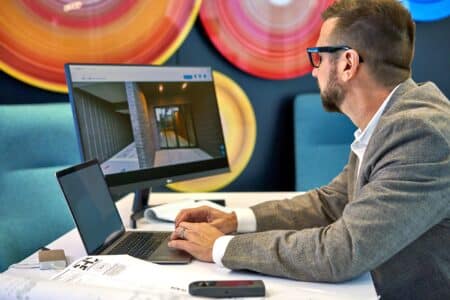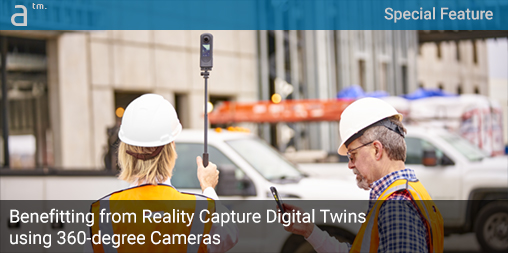THE GLOBAL PANDEMIC IN 2020 accelerated the need for visual access to the construction site on an entirely different level. It wasn’t just the difficulty and time required to travel to the job site that was the area of potential efficiency gain. AEC professionals were working from home and living with travel restrictions and limited availability of access to the job site itself. Now the pandemic has subsided, and travel has resumed, AEC workflows have shifted to being more digitally-minded.
The Job Site in 360
Under this condition, AEC professionals, particularly architects, engineers, and senior construction professionals, needed new ways to monitor the job site’s progress. They found their solution in a new class of digital tools called “reality capture.”
Using still image and video cameras as capture devices, like the RICOH THETA X 360-degree camera, a new family of reality capture software platforms sprung up and matured quickly during the pandemic years because AEC firms benefitted so much from their deployment. So, what do reality capture software platforms do, and what are all the problems they solve?

In this view, a construction professional monitors work progress inside an office using RICOH360 Projects. Reality capture digital twins are easy and cost-effective to generate using a 360-degree camera like the RICOH THETA cameras combined with a platform like HoloBuilder or RICOH360 Projects (shown above).
Reality capture platforms provide an immersive virtual experience that simulates being on the job site—they develop a “digital twin” of the job site. As such, these systems, first and foremost, reduce site visits because AEC professionals can virtually inspect, review, compare, annotate, and take measurements from anywhere they can access the Internet and the software.
But using AI (artificial intelligence), reality capture-based digital twin software systems can analyze and track progress, comparing digital twins constructed from reality capture media to BIM models. Systems like HoloBuilder and RICOH360 Projects can enable side-by-side visual comparison so AEC professionals can catch and resolve construction mistakes before they happen or early. Such systems also log the digital twin as it develops from newly ingested media, and this data can prevent disputes and finger-pointing.
Critically to AEC professionals, reality capture-based digital twins facilitate better collaboration between all stakeholders when solving issues because these systems allow you to see behind closed-up walls, ceilings, and floors. In short, they provide a quasi-X-ray vision technology for buildings.
HoloBuilder and Similar Solutions
While there are multiple reality capture platforms in the AEC industry—a very fast-moving space in the contech market—a standout leader is HoloBuilder, a FARO company.
HoloBuilder is a leading platform for construction progress management. As a reality capture software platform, users take 360-degree photos from all the rooms and areas of a job site, including exteriors if desired, and then load them into the HoloBuilder application.

HoloBuilder is one of the key leaders in reality capture platforms for digital twins in the AEC industry. The system is cloud-based and accessible from all device types. Mobile apps are critical parts of the workflow and even pair with 360-degree cameras like the RICOH THETA X shown in the image.
HoloBuilder then automatically stitches up all the 360-degree images into an immersive 3D photographic digital twin that can be explored room by room and across time scales for various comparison functions. HoloBuilder can also make a side-by-side visual comparison against a BIM model, which is a critical way to monitor construction progress against design intent as well as being able to troubleshoot issues that may arise in the field.
HoloBuilder has also introduced VideoMode in beta as part of its HoloBuilder JobWalk app. Their introduction of this feature shows a construction professional holding a RICOH THETA X camera on a handheld tripod as he walks inside a building. JobWalk, the app, controls the interaction with the THETA X 360-degree camera.

HoloBuilder can generate reality-capture digital twins and compare them to BIM models in side-by-side windows. As you turn and spin in one window, the other window turns in sync. An AEC professional can monitor what has been constructed and compare it to what remains to be built by comparing it to the BIM model.
HoloBuilder and similar apps typically ingest video, 360-degree photos, and even 2D photos to document a construction job site. In some cases, 2D images can be pinned to the digital twin, like written markup and voice notes. So, when you collaborate on a reality capture digital twin, and you need to take a higher resolution zoomed-in photo, that picture can be linked into the digital twin at precisely the location that makes sense.

The RICOH THETA X is purpose-built for the AEC industry and a leading 360-degree camera often recommended by the reality capture software platforms in the industry. (Shown here next to HoloBuilder).
In addition to HoloBuilder, the leader in the market in this kind of reality capture software, there are several others, and nearly all of them work in conjunction well with the RICOH THETA X 360-degree camera. Architosh will cover them all in an upcoming feature inside our monthly newsletter Xpresso (so sign up!).
I do want to point out two more reality capture solutions—RICOH360 Projects and RICOH360 Tours. But first, we will discuss camera details in the next section.
The Perfect Camera for Reality Capture
When it comes to the best camera for 360-degree capture, including video for walk-around work, the RICOH THETA X shines above many others. Many reality capture software companies provide comparison guides, and typically these guides show the RICOH THETA cameras as the top performers.
StructionSite, a competitor to HoloBuilder, notes that the RICOH THETA Z1 camera has the best-low light performance compared to the insta360 ONE RS 1-inch 360 Edition and other cameras, for example. Once walls are formed, many buildings can become quite dark, and low-light performance becomes the most critical issue. If you can’t see things in your reality capture media, no matter what software system you use to create 3D digital twins for construction, you are stuck with limitations that will force you back to the job site.
This was a prominent point made in an Architosh-hosted webinar titled RICOH THETA X for AEC Webinar—Digitizing the Jobsite using 360-degree Images. Our panel of architects and construction professionals testing the latest RICOH THETA X camera noted several things of importance to using 360-degree photography on the job site.

The RICOH THETA X camera is shown next to a smartphone running the associated app by RICOH. Once an image is taken, it syncs to the photos on the smartphone, and the user can rotate the 360-degree spherical image on the phone.
The RICOH THETA series of 360-degree cameras include models for the consumer and professional. Their pro models include the THETA X and THETA Z1. The THETA X is the latest model aimed explicitly at the AEC industry. It uniquely features a 2.25-inch LCD screen and easy to use swipe gesture user interface to navigate around the camera’s controls.
The THETA X supports both 5K and 11K spherical 360-degree images and 5K video. The THETA X comes with plenty of internal memory. At 46 GB, it can hold up to 11,500 still images in the 5.5k format or 4,600 photographs in the 11k format. There is also a microSDXC memory card slot on the unit. Most users in AEC/O will be transporting their photography to project directories on the LANs, cloud storage, or CDE (common data environment) software systems as a matter of standard protocol. Still, it is nice to know you can store many images in the unit’s internal memory.
RICOH360 Tours/Projects
While this article mainly focuses on the excellent pairing of HoloBuilder with the RICOH THETA X camera, the Japanese tech giant also offers two cloud-based solutions with various differences and feature overlaps. We have already noted RICOH360 Projects a bit above as the most similar app to HoloBuilder. RICOH360 Projects boasts a construction industry focus with the noted side-by-side comparison time-stamped and synched 360-degree image view capabilities, in addition to markup features and more. Architosh has written about Projects in more depth in prior features here.
MORE: STA of Boston Gains Efficiency with RICOH THETA X 360-Degree Cameras
RICOH360 Tours is the other solution of note, working beautifully with RICOH’s THETA 360-degree cameras. This application is ideal for the AEC industry and the real estate industry, from which it provides its most compelling value propositions.
RICOH360 Tours is an excellent application for creating high-quality “virtual tours” and videos. The software offering uses AI technology to enhance the images and automate many processes, complete with the auto-creation of a marketing video of a property. Tours can also use AI to automate the creation of very attractive 2D images highlighting various parts of a building’s spaces and forms. And this includes creating tours of the construction job site as well. Such virtual tours of a building while under construction can help clients and client reps monitor the construction progress remotely over time, lessening the need for costly travel.

Architects also benefit from reality capture digital twins, allowing them to monitor construction from their offices and better collaborate and solve issues in the field with the general contractor.
For the real estate industry, professionals will likely be very pleased with RICOH360 Tours and its ability to generate floor plans from 360-degree imagery alone. They will also be impressed with RICOH360 Tours’ AI Virtual Staging Beta features. This AI technology virtually “stages” furniture into a space, enhancing the attraction for real estate buyers.
In talking to Bobby Main of STA of Boston (see, Architosh: “STA of Boston Gains Efficiency with RICOH THETA X 360-Degree Cameras,” 25 Oct 2022 ), I learned that their experiences using the THETA X camera led to thinking about additional services they could provide to clients in the form of post-build and post-occupancy “digital twins.” RICOH360 Tours’ capabilities to create attractive virtual tours of spaces means being able to add digital assets to corporations and enterprises that serve the needs of facility managers and corporate architects.
Final Thoughts
While reality capture tools are primarily contractor-led technology, they are also deployed by architects, interior professionals, engineers, construction management firms, and real estate development professionals. An affordable 360-degree camera like the RICOH THETA X, when paired with a tool like HoloBuilder, becomes a powerful platform for monitoring construction job sites from afar.
Since the global pandemic—and the COVID-19 crisis is not truly over—the nature of work in AEC has changed for good. These technologies, accelerated by necessity, bring about efficiencies like saving AEC professionals from traveling to the job site. But more than that, they provide numerous other unique benefits that did not exist a few years ago.



